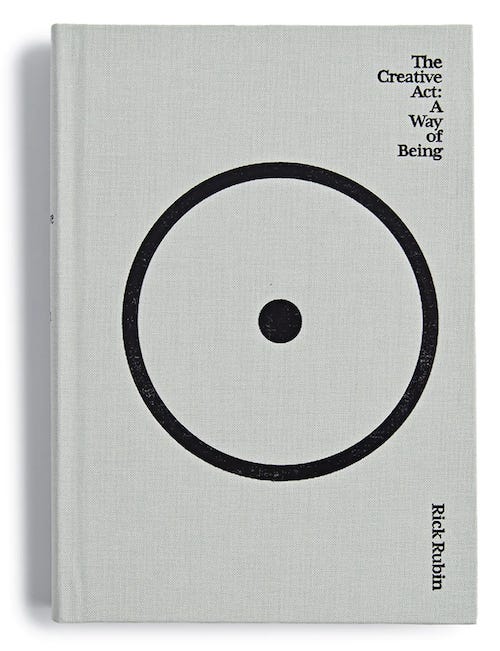A Primer on Cultivating Taste from Legendary Producer Rick Rubin
I've always felt that product design was a creative endeavor and the work that most moves our industry forward stems from practitioners who could easily be described as artists. Given this, I've often wondered whether one of the best ways to improve our craft as product designers would be to immerse ourselves in the best practices of artists at large. I got the chance to explore exactly that when legendary producer Rick Rubin, behind iconic artists like Adele, Linkin Park, and Red Hot Chili Peppers, published his new book. In The Creative Act, Rubin shares everything he has learned about harnessing your creativity from his decades working with some of the most successful recording artists of our time.
While I found the book most applicable to the traditional realms of music, writing, and art, I thought Rubin's perspective on where creativity comes from and how one can develop taste equally applicable to product design.
Rubin quickly dispels the notion that creativity comes from original thought. He says our mind will often deceive us into thinking this is the case, but the reality is far from it. Instead the source material from which creativity emerges is always from the outside world that surrounds us, which we sense, tune into, and remember. Sometimes we actively reference this source material, but equally often it manifests in dreams, intuitions, and subliminal fragments beyond our conscious state. What make art unique is how we uniquely combine various source material with our own interpretation of it to create something entirely new.
From this insight on the source of creativity, Rubin draws two specific implications. The first is that we need to cultivate our awareness to be able to take full advantage of the source material the world has to offer. The reality though is we all have a filter through which all source material is processed before we get to appreciate it. This filter exists because our memory space is limited and we have limited processing power to take in all the information that surrounds us. So instead we learn early to focus on information that appears essential or of particular interest to us and tune out all the rest. But as an artist, "we seek to restore our childlike perception: a more innocent state of wonder and appreciation not tethered to utility or survival." He describes artists as having a greater sensitivity to their environment and their task then becomes finding a way to share what they perceive with the rest of us as art. Rubin shares a variety of techniques for cultivating this, from not holding our belief systems too dearly, to learning to notice our own emotional state as we consume art, to actively changing our perspective to try to see something new. This all is in an effort to increase of aperture and perceive far more signal from the creative sources out there.
For product designers this means cultivating your awareness as you engage with every product around you. Not only other products in your chosen field, but each and every product you come across as you simply go about your life. Product designers who have cultivated this sensitivity can point out flaws or trade-offs made in each and every product they come across. They are also equally adept at noticing when something is a particularly pleasurable product experience and how that experience made them feel. It's important to note that often this awareness might not be easily communicated in words. For example, you might not be able to describe exactly why something is particularly pleasurable or not, but building that awareness even without the words can still improve your sensitivity at a subconscious level.
The second major implication of Rubin's insight into the source of creativity is how we should think about what we consume. Rubin encourages us to submerge ourselves in the canon of great works, whether its "reading the finest literature, watching the masterpieces of cinema, or getting up close to the most influential paintings." There is no standard list for this canon as its continually changing with the times, so you do have to do some leg work to put it together. He emphasizes that the point of doing so is not to strive to imitate the best, but instead to increase our own sensitivity to what greatness looks like. He is essentially describing using this as a method for developing our taste.
As I think about how to apply this to my own role as a product designer of digital products, I find myself thinking about where could I find the canon of great works in my field. Maybe it's immersing myself in the Apple Design Awards winners, which are the most critically acclaimed apps chosen by Apple. Or diving deep into the all-time top upvoted apps on Product Hunt. Or diving into the product experiences of the fastest growing B2B apps. All of these efforts will certainly help me cultivate my sense of taste which becomes critical as I embark on bringing my own creative product designs to market.
Immersing myself in the practices of traditional artists was an eye opening experience that gave me a new perspective on my own work as a product designer. You might find similar inspiration from reading Rick Rubin's Creative Act.
Whenever you’re ready, here are 3 ways I can help:
AI Productivity: Learn how leading product managers use AI to become faster, smarter, and gain super powers beyond their traditional role.
Mastering Product Management: Accelerate your product career by learning rigorous frameworks for each PM deliverable, from crafting a strategy to prioritizing a roadmap.
Product Innovation Strategy: Building a new product? Learn how to leverage the Deliberate Startup methodology, a modern approach to finding product/market fit.


